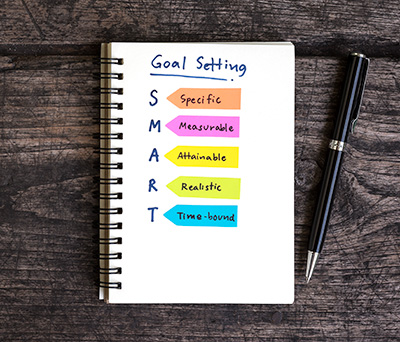A successful wellness program isn’t as simple as just communicating company benefits and offering a few additional services—especially in today’s work environment where it’s a challenge keeping employees happy where they are.
Instead, effective wellness programs have to be designed to meet employees where they currently are and where they will be as they progress on their wellness journeys.
This means your wellness program should never be static.
It must educate, engage, and evaluate in an endless loop with checkpoints that let you know whether or not it’s on the right track.
So, what are those checkpoints? Let’s examine the four main phases of the wellness program lifecycle and which milestones and tactics should be implemented into your strategy.
Four Phases of Wellness Program Development
Corporate wellness programs have numerous moving parts and require a tremendous amount of planning and execution that can be broken down into four main phases:
1. Identifying challenges, needs, and goals
2. Designing infrastructure
3. Strategizing program development
4. Evolving the program
Let’s look at the milestones for each phase, starting with identifying employee needs.
Phase 1: Identifying Challenges, Needs, and Goals
The first phase involves finding out where your employees are on their wellness journeys and what they need to achieve their best health. That also means understanding the factors that get in the way of them achieving their health and wellness goals.
The most important milestones within this initial phase are:
 Gather Clear Feedback From Employees
Gather Clear Feedback From Employees
There are myriad ways to gather feedback and data about employee needs. For example, you can use employee surveys to identify meaningful and measurable data about what’s important to employees, whether there are existing benefits to address those priorities, and what’s missing.
This type of feedback can help you understand:
- What employees need to feel empowered and engaged in a program
- What a culture of well-being means to employees
- Where employees are aligned with regard to their needs
- What generational differences exist within the workforce
“When we help clients through the wellness program development process, among the first things we look at are their website, their vision, their mission, and their values. Are they LEED-certified, rooted in philanthropy, or committed to DEI issues? Are they family-owned, public, or private? All of these questions provide valuable information about what their employees expect and need.”– Courtney Schroeder, Wellbeing Strategy Consultant
Conduct an Audit of Existing Services
It’s also critical to know what’s already available to employees and whether they’re using those services or not. You need to be crystal clear about what your third-party vendors offer for each element of wellness, from emotional to financial to physical and so on.
Create a Realistic Measure of Engagement
Every company would love to hit the gold standard of 80% engagement. Many of our clients do. But it’s nearly impossible to create an achievable plan for that level of engagement if you haven’t first established what your baseline is.
How do you know you’ve done your due diligence in this phase? Seek out the answers to the following questions:
- Which existing services have the most engagement?
- What improvements do employees want to see?
- What are the actual engagement totals (number of employees) for each service?
- Are all employees engaged, or is there a lack of representation?
- Which groups are engaged and which are not?
Develop SMART Goals
Using all the information gathered, you need to clearly articulate goals that can be tracked directly to KPIs. The best goals are SMART goals: specific, measurable, attainable, realistic, and time-bound.
 By creating three or four SMART goals, you’ll then be ready to move to the next phase: designing your wellness program.
By creating three or four SMART goals, you’ll then be ready to move to the next phase: designing your wellness program.
Phase 2: Designing Infrastructure
 A corporate wellness program is only effective if it addresses all employees’ needs. That requires a tremendous amount of planning, research, and evaluation, as indicated in the previous section. Using the information gathered, you can begin the real work.
A corporate wellness program is only effective if it addresses all employees’ needs. That requires a tremendous amount of planning, research, and evaluation, as indicated in the previous section. Using the information gathered, you can begin the real work.
Meet Employees Where They Are
Wellness programs need to have meaningful elements that span the lifecycle of each employee, no matter where they are on their journey. That means the portfolio of programs and services you offer has to cover the entire employee continuum.
So, how do you know if you’ve accomplished that goal during the design process?
One way to determine if you’ve successfully covered your bases is by looking at utilization. Are your programs being utilized all across the employee continuum? Unless your employee demographics are limited to one group, you should be seeing employees taking advantage of nearly all programs and services at some point.
Leverage Rewards
Another factor that demonstrates proper design pertains to incentives and rewards. Both should be moving the needle on engagement and the completion of wellness challenges and programs.
If you’re finding that you’re getting the same results whether or not an incentive or reward is provided, you may not have the right design in place. That’s fairly easy to fix in the grand scheme of things.
Make sure both incentives and rewards are worth the budget and time it takes to design and implement them.
– Samantha Reid, WellRight Well-being Strategy Consultant
Phase 3: Strategizing Program Development
Your wellness program implementation should be well-planned and include a rollout schedule that ensures smooth onboarding and optimal engagement. One of the biggest mistakes we see clients make is reinventing the wheel instead of taking advantage of ready-to-roll-out programs.
Take Advantage of Partner Relationships
It should go without saying that your wellness program design has to be built around existing benefits such as EAP, 401(k), and your company’s overall health plan.
But there are additional benefits to think about—those offered by your third-party vendor relationships.
Take, for example, our partnerships with digital mental health solutions Animo and TextCoach™, which offer professional mental health care to employees without requiring them to step foot in a practitioner’s office.
Animo applies cognitive behavioral therapy (CBT) and gives employees 24/7/365 access to mental health resources online or via their mobile devices. Starting with a scientific DASS-21 assessment, employees get personal recommendations for CBT-based modules that address issues such as depression, anxiety, and stress. The program also offers a full library of emotional fitness tip sheets, flash courses, and games.
TextCoach™ is a secure, text-based mental health counseling service that connects independently licensed clinicians with employees through text messaging without restrictions on the number of messages or the hassle of appointments, wait times, or judgment.
Too often, companies overlook their benefit partners or those offered by their wellness program partners. Make sure to consider third-party services, including stress management, mindfulness, basic budgeting, and more.
Phase 4: Evolving the Program
We pointed out earlier that your wellness program shouldn’t be static. It has to continuously adapt to employee needs, changing trends in the industry, and emerging tools and technologies.
Align With Your Strategic Plan
Remember when we mentioned SMART goals? This is where they’re most critical. What’s your company’s long-term strategy, and can your wellness program scale?
In today’s recruiting and retention race, no employer can afford to have a sub-par wellness program offering. So, if your company has a long-term goal related to hiring more women, BIPOC employees, or LGBTQ+ employees, your wellness program must have the appropriate programs in place.
Some questions to ask about scalability include:
- Do you have established employee resource groups?
- What does your diversity, equity, and inclusion programming entail, and is it truly inclusive?
- Does your communication strategy take language and vernacular into account?
- Have you looked at your wellness program from a health equity lens?
- Could any employee—regardless of socioeconomic factors or geography—find a program or service that resonates with them?
These same questions apply to changes related to mergers and acquisitions, global expansion, remote work environments, and a host of others.
“We ask our clients about the decisions they’re considering for the future. The last thing we want is for their wellness programs to be siloed from their organizational goals. They need to almost anticipate and create opportunities for future growth.”– Courtney Schroeder, WellRight Wellbeing Strategy Consultant
If your company is struggling with developing a wellness program or if you’re in the process of revamping an existing program, WellRight is here to help. We have the resources and expertise to help you create a purpose-driven, person-centric program that appeals to every employee in your organization.



